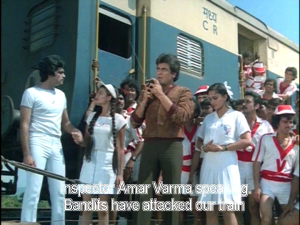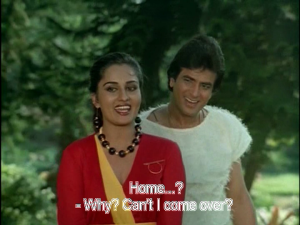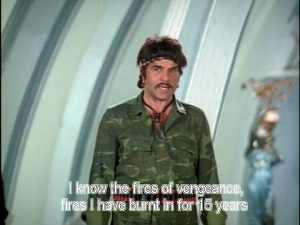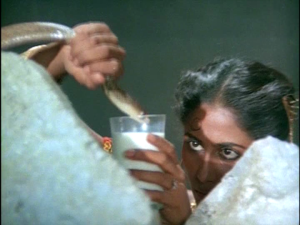Sometimes when the world has gone mad, you just need the reassuring presence of The Big B dishing out dishoom and justice.
Shiva and Aslam grow up besties in one of those happily diverse communities. Their dads are also friends, teasing each other about being rubbish at being a Muslim or a Hindu because they can’t even remember their own religious celebrations. Both dads make a powerful enemy when they stop a flamboyantly bewigged and fringed Kader Khan killing a bloke. He decides to foment communal strife in order to kill them without the police suspecting him, and somehow this is linked via a montage to Partition. The family is torn apart by a house fire that kills Ram and Rahim, leaves Aslam lost, and places young Shiva with Aslam’s ma (Nirupa Roy) as his only family.
The kids are indifferent actors, probably chosen for their evolutionary potential to end up looking like neighbourhood thug Shiva, aka Tiger (Amitabh Bachchan), and principled dacoit Shera (Vinod Khanna). Tiger hasn’t forgotten his past despite being raised by Nirupa Roy while Shera is trying to find death, but even death is worried by his body count.
Amitabh gets the best and worst of the film. Shiva/Tiger is an impulsive thug who is motivated by the right reasons but doesn’t stop to think about collateral damage or even just stop to think, a dictator in his own manner. He also gets stuck with a wardrobe that I wish I could say was part of the comedy track. It annoys me so much that he is called Tiger yet wears leopard print. Really! But Amitabh has such charm that the glib one-liners work a treat and he can switch effortlessly to show Shiva’s darker side. And some of the comedy track is funny despite itself. I particularly enjoyed the wedding party being entertained and fed by the crooks who had come to steal the bride. I suppose in a different film, Tiger could always have picked up work as an event planner.
Tiger sees the curvaceous and feisty Chanda (Rekha) at the market and is smitten. She challenges him to back up his bragging by wrestling a tiger for her. So he does. But Chanda has been engaged to gangster Raghu (Ranjeet) since childhood, and he is not inclined to give up his claim. Raghu tries to get Shera to kill Tiger but Shera says it would be better if Raghu died. Raghu has other ideas and starts messing with Zaleem Singh who is still alive and scheming.
Shera still mourns his lost family, and believes himself alone in the world. Like Shiva, he has a strong commitment to justice as he sees it, and like Shiva he doesn’t pay attention to the law. Vinod Khanna was saddled with some dodgy hair and a lot of pleather, but Shera is certainly the cooler of the grown up boys. Probably because he doesn’t have his mummy choosing his outfits. But he is also afflicted with the faux leopard trim. Vinod delivers his cheesy lines with a detached and weary cynicism threaded with sentimentality about families and honour. It’s the kind of role that I usually expect to see Danny Denzongpa in and I think he might have added a little more spark to the pathos. The long lost friends spend almost all the film apart and their few scenes together are good. I wish they had interacted a bit more to ramp up the tension a bit.
Chanda faces Raghu down with the full support of her father who says she cannot be married off against her will. Hurrah for that dad! Naturally Raghu decides to eliminate Tiger, but being a weasel he takes many indirect routes rather than simple confrontation. Rekha’s body language is quite masculine and often aggressive in Chanda’s pre-marriage scenes. She owns her space and doesn’t let unwanted contact go past without payback. She falls for Tiger but then he plays hard to get. They have a push and pull in their dynamic that is amusing but not emotionally healthy. And when it comes to Tiger choosing between his wife or his ma, you’d better believe he is a mummy’s boy who will slap his wife into the middle of next week if she disagrees with Ma. Rekha and Amitabh have that chemistry of course, but I enjoyed Chanda’s scenes where she was going about her daily routine alone and her interactions with other people in the village. Rekha can be funny as well as dramatic, and despite a few airhead moments Chanda is quick-witted and interesting.
Shanno or Shantidevi (Aruna Irani) is another defiant woman. She loves her husband Mohan (a very restrained Asrani) who is a gentle, law abiding man and they talk about their conflicting beliefs and all seems really respectful and solid. Except when Mohan is threatening Shanno to prevent her from telling her brothers or when Shanno is telling Mohan to pop on some bangles and let her be the man of the family. Shanno also happens to be Zaleem Singh’s daughter and bears her Monobrow of Fury with elan. Her immediate reaction to any insult is to grab a gun and try and kill the offender, saying her brothers will clean up the legal issues. When Raghu burns down their farm and pretends he is Tiger, it sets up yet another conflict. After a tense family visit, and a huge random edit, Mohan decides to go kill Tiger so Shanti also runs off after him with a gun.
Shiva relocates to the jungle and ends up working on a plantation owned by Zaleem Singh. He gets a nice Kalyanji-Anandji number that looks like a rehearsal for Mr Natwarlal, and Helen makes an appearance to dance for the landlords. He builds new relationships and becomes the voice of workers’ rights and social justice. There’s even an “I’m Spartacus” scene. Chanda is gradually sidelined but she remains a strong force in the film and in Shiva’s life. Nirupa continues to give him pointless and conflicting instructions. The lack of emotional blackmail opportunities drives her to almost commit a crime so she can stop herself and “Nahiiiiin!” about it.
There are so many bad guys! Ranjeet gets his shirt off for no reason, Kader Khan is slimy and arrogant as Zaleem Singh, Mac Mohan is natty in pleather as Singh’s flunkey, Vinod Khanna is a cut above this material, and there are so many beefy shirtless dudes running around beating people up that I suspect that was the main industry for the village. There are also abundant good guys, many of whom speak with sense, logic, and empathy. It’s quite pleasing to have some good life advice doled out to the hero.
And all the while Shera is on Tiger’s trail, paid to hand Tiger over to Zaleem Singh but not really believing that he is a miscreant.
What happens next? Please, you already know. And yet there is always that bit extra that makes you go “Huh?” The action scenes are woeful as I don’t think Rakesh Kumar had the faintest idea of how to shoot or stage a fight so there is minimal choreography of the stunts and lots of bizarre angles and edits to skip over the lack of detail. There is a very long and quite unnecessary horse chase, although it did prove Moti knew what was what. It’s the kind of film where wallowing in quicksand is not enough, you have to simultaneously wrestle a snake. It’s the kind of film where if you want to kill someone you have to first build an enormous wooden edifice and tie them to a stake at the top. It’s the kind of film where Moti the horse should have been making key decisions.
Despite being quite slapdash, the story contains some interesting little bits and pieces. See it for Amitabh and Vinod emoting fiercely with Rekha and Aruna Irani being fierce. 3 ½ stars!










































































